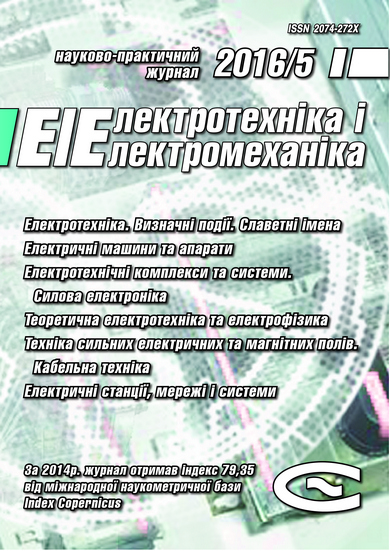AN INDUCTION SENSOR FOR MEASURING CURRENTS OF NANOSECOND RANGE
DOI:
https://doi.org/10.20998/2074-272X.2016.5.09Keywords:
magnetic field strength, corona current, surge characteristic, electromagnetic induction, bi-exponential pulse, induction transformer’s calibration, distributed parameter lineAbstract
Purpose. A current meter based on the principle of electromagnetic induction is designed to register the current flowing in the rod lightning. The aim of the article is to describe the way of increasing the sensitivity of the converter by means of their serial communication. Methodology. The recorded current is in the nanosecond range. If compared with other methods, meters based on the principle of electromagnetic induction have several advantages, such as simplicity of construction, reliability, low cost, no need in a power source, relatively high sensitivity. Creation of such a meter is necessary, because in some cases there is no possibility to use a shunt. Transient properties of a meter are determined by the number of turns and the constant of integration. Sensitivity is determined by measuring the number of turns, the coil sectional area, the core material and the integration constant. For measuring the magnetic field pulses with a rise time of 5 ns to 50 ns a meter has turns from 5 to 15. The sensitivity of such a meter is low. When the number of turns is increased, the output signal and the front increase. Earlier described dependencies were used to select the main parameters of the converter. It was based on generally accepted and widely known equivalent circuit. The experience of created earlier pulse magnetic field meters was considered both for measuring the magnetic fields, and large pulse current. Originality. Series connection of converters has the property of a long line. The level of the transient response of the meter is calculated. The influence of parasitic parameters on the type of meter transient response is examined. The shown construction was not previously described. Practical value. The results of meter implementation are given. The design peculiarities of the given measuring instruments are shown.References
1. Chernuhin A. Yu., Kniaziev V.V. The streamer corona from the rod lightning arresters. East European Scientific Journal, 2016, no.6, iss.2, pp. 39-46. (Rus).
2. Nemchenko Yu.S., Lesnoy I.P., Lantushko B.N, Knyazev V.V. Metrological maintenance operation of high-voltage pulse electric discharge equipment. Bulletin of NTU «KhPІ», 2004, no.35, pp. 29-54. (Rus).
3. Shalamov S.P. Measurement of pulsed magnetic fields. Bulletin of NTU «KhPІ», 2014, no.50, pp. 161-168. (Rus).
4. Nemchenko Yu.S. Wideband means of measuring pulse magnetic fields. Bulletin of NTU «KhPІ», 2007, no.20, pp. 132-146. (Rus).
5. Nemchenko Yu.S., Shalamov S.P. Induction converter pulsed magnetic field of lightning. Bulletin of NTU «KhPІ», 2015, no.20, pp. 99-108. (Rus).
6. Power Electronic Measurements Ltd (PEM). Available at: http://www.pemuk.com/publications.aspx (Accessed 08 April 2013).
Downloads
Published
How to Cite
Issue
Section
License
Copyright (c) 2016 S. P. Shalamov

This work is licensed under a Creative Commons Attribution-NonCommercial 4.0 International License.
Authors who publish with this journal agree to the following terms:
1. Authors retain copyright and grant the journal right of first publication with the work simultaneously licensed under a Creative Commons Attribution License that allows others to share the work with an acknowledgement of the work's authorship and initial publication in this journal.
2. Authors are able to enter into separate, additional contractual arrangements for the non-exclusive distribution of the journal's published version of the work (e.g., post it to an institutional repository or publish it in a book), with an acknowledgement of its initial publication in this journal.
3. Authors are permitted and encouraged to post their work online (e.g., in institutional repositories or on their website) prior to and during the submission process, as it can lead to productive exchanges, as well as earlier and greater citation of published work.





